Whether they are inviting, serious, engaged, or relaxed and cool, voices in marketing videos have just a few seconds to evoke emotional responses that are both memorable and convincing. But who are the real people behind these unique voices, and how does a really good soundtrack get created? In this article, we take you behind the scenes to accompany a professional speaker during his recording session in our sound studio.
Preparation
Several things have already happened before recording begins. First and foremost, the speaker was chosen from a range of professionals during a casting session in which the customer determined that he (or she) was the ideal talent for the current project.
Today’s recording will be a two-minute marketing video in Japanese, for which the customer chose our industry veteran speaker Akira. A few days before the session, we contacted him to arrange the recording time and negotiate the budget for the project. Since then, he has rehearsed for the recording based on a specially prepared Japanese script. This script contains detailed guidelines about how certain words or phrases should be pronounced or emphasized, and other relevant instructions that will produce the optimal results in the shortest amount of time. He has also studied the English source video in order to understand the general ambiance that needs to be portrayed within the context of Japanese language and culture.
The Session
Most speakers arrive at the studio about 15 minutes before we begin recording. They take this opportunity to sort through their scripts and notes in peace and quiet, have a refreshing drink before starting (most speakers prefer plain water; coffee is not quite as popular) or chat about the day’s session or other current projects.
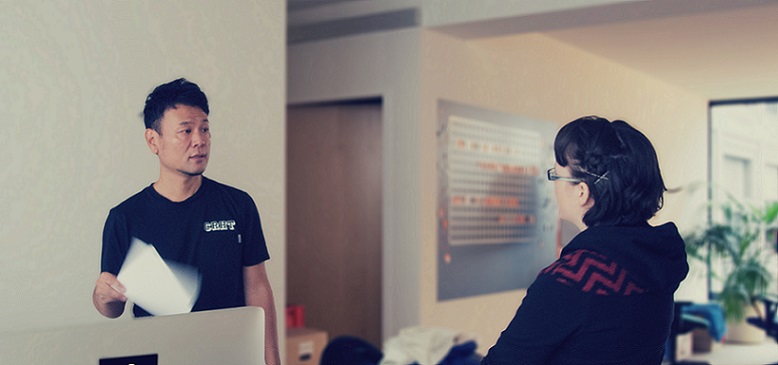
The sound engineer running the session, the responsible project manager, and sometimes a customer representative accompany Akira during the session. In special cases, there is also a native-speaking language director. Before the session starts, any remaining questions regarding the script or the appropriate pronunciation of product names or foreign words are clarified. Any specific customer requests regarding the manner of speaking, tone of voice or tempo are also taken into account.
After this short briefing, the video is played so that Akira can “get into the zone.” Then he disappears into our soundproofed recording booth. The engineer performs a sound check and verifies that all devices are working properly and the software is set correctly. Because the soundproofing prevents direct audio contact between Akira and the outside staff, they communicate via headphones, and a window in the wall of the booth allows eye contact.
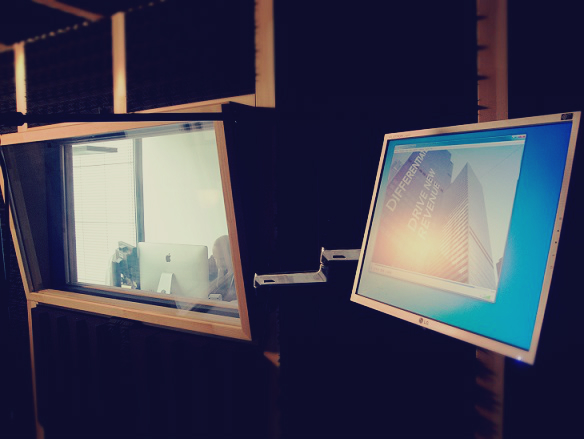
Looking into the booth, we can see not only Akira in his headphones, but also a professional-quality studio microphone, a podium for arranging the script, lighting and a monitor for following the video while he speaks.
Now the recording can start! Through his headphones, Akira hears the original English video text at a low volume, and simultaneously speaks the Japanese script so that both the timing and the tone of voice match perfectly. How he actually manages to do that every single time continues to amaze us. It is truly a rare talent that distinguishes professional speakers from the rest of us and, to the uninitiated like us, will forever remain a puzzle.
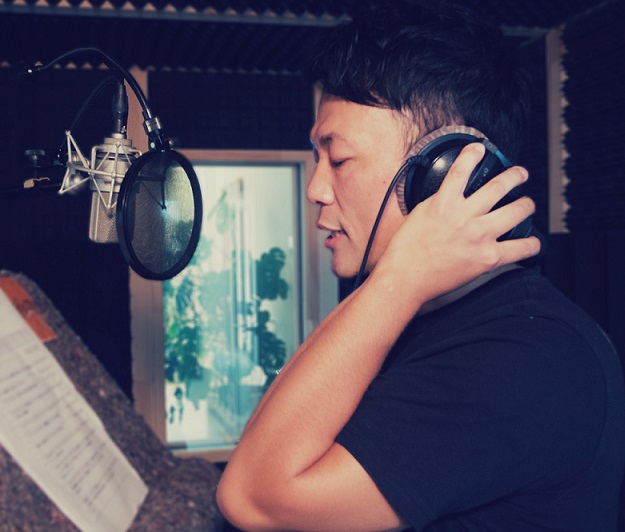
Occasionally, slip-ups or other disturbances such as turning pages will be picked up by the microphone. These faults are corrected immediately so that, by the end of the session, a complete soundtrack has been created.
The soundtrack is now carefully monitored (Is the timing right? Is the diction correct and clear? How is the sound quality? Does the tone of voice reflect the customer’s wishes?). If everything is as it should be, the speaker’s work is done. For Akira, the only remaining task is to write an invoice. Now all he has to do is wait to someday see (or hear) the final video.
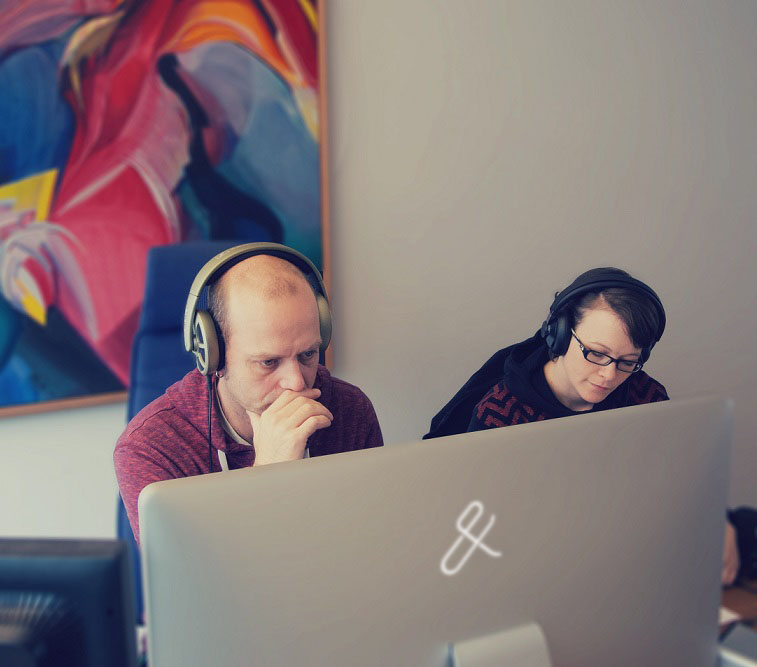
But the sound engineer can’t relax yet. As soon as Akira is finished, the engineering work begins. The soundtrack will be professionally reworked, mastered, cleaned and cut. Depending on the project requirements, the recording can either be delivered as a pure soundtrack (usually in WAV or MP3 file format) or it can be timed and embedded in the video content, and produced in the appropriate format, for example in MOV, MP4 or WMV. The finished files are sent to the customer.
Only after the customer has given his or her final approval is the recording project considered complete.
(Summary: The work never stops in text&form’s Multimedia department! Week in and week out, vocal cords vibrate, fingers type, printers print, computers hum and steam blows out of our specialists’ ears, but, in the end, a precise two-minute soundtrack is produced. It is one that will strike the perfect emotional chord and echo in listeners’ memories!)
The Speaker
Hi Akira, how are you doing after today’s recording session?
Great, thanks!
How long have you been working as a voice talent?
I began in 2007.
How did you get started?
A friend took me to an audition with him and, as one says, the rest is history! Right from the beginning, working as a voice talent was a lot of fun. I must say, though, that I found the thought that my voice would be heard by thousands of people and that I had no influence over the actual transmission rather overwhelming. But I don’t worry about that anymore.
What do enjoy most about your job?
As a freelance voice talent, one has a lot of freedom. Most of the recordings are quite short, which I like, and also I enjoy the variety. I get around a lot, working at different studios and companies, and being involved in interesting projects. Plus, I won’t deny that I value the frequent positive feedback and praise for my voice.
What do people like about your voice?
I get quite a lot of contracts for eLearning projects. I’m Japanese, and I apparently have an unusually low, but warm and friendly voice. It seems that my customers find my voice very well suited for educational content. One could say that it is especially valuable within the context of teaching.
The Project Manager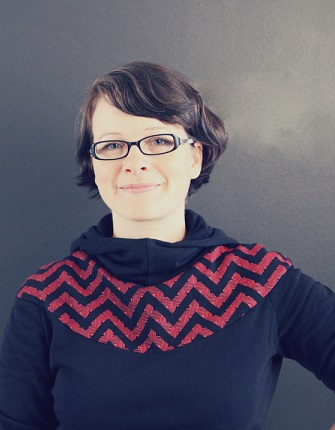
Hi Miriam. What did you record today?Today we recorded a marketing video for an international IT company in several languages, including Japanese. We just finished recording the soundtrack for the video with Akira.
Did the customer have any special linguistic requirements or wishes?
Yes, the customer uses a certain tone of voice in their marketing communication that the speaker needs to emulate as closely as possible. Additionally, he should come across as likeable, honest, and accomplished. Aside from that, there were the usual time constraints that Akira had to adhere to while speaking a different language than the original.
How much does the project manager need to prepare before the voice talent comes into the studio?
We project managers are in contact with the customer right from the beginning. We discuss any exact localization issues and the scope of the audio dubbing. We also consult with the customer about the style of the recording (for example, voiceover or synchronized), and we offer a selection of appropriate voice talents. If necessary, we coordinate the script translation and perform length checks to ensure that the translation will fit the timing requirements imposed by the video.
After the customer chooses a voice talent and the translated script is finalized, we set up an appointment for the recording and we send the speaker the script and any relevant diction instructions plus the video content. If the customer so wishes, we also set up their participation in the recording session. In other words, before the speaker enters the studio, we have already been exceedingly busy!
What do you have to do after the recording session?
After the session, we listen carefully to the complete recording. Subsequently, the soundtrack is reworked by the sound engineer and, if necessary, embedded in the video. After we are convinced that we have satisfied all of the requirements, we send the final recording to the customer. Then we celebrate!

